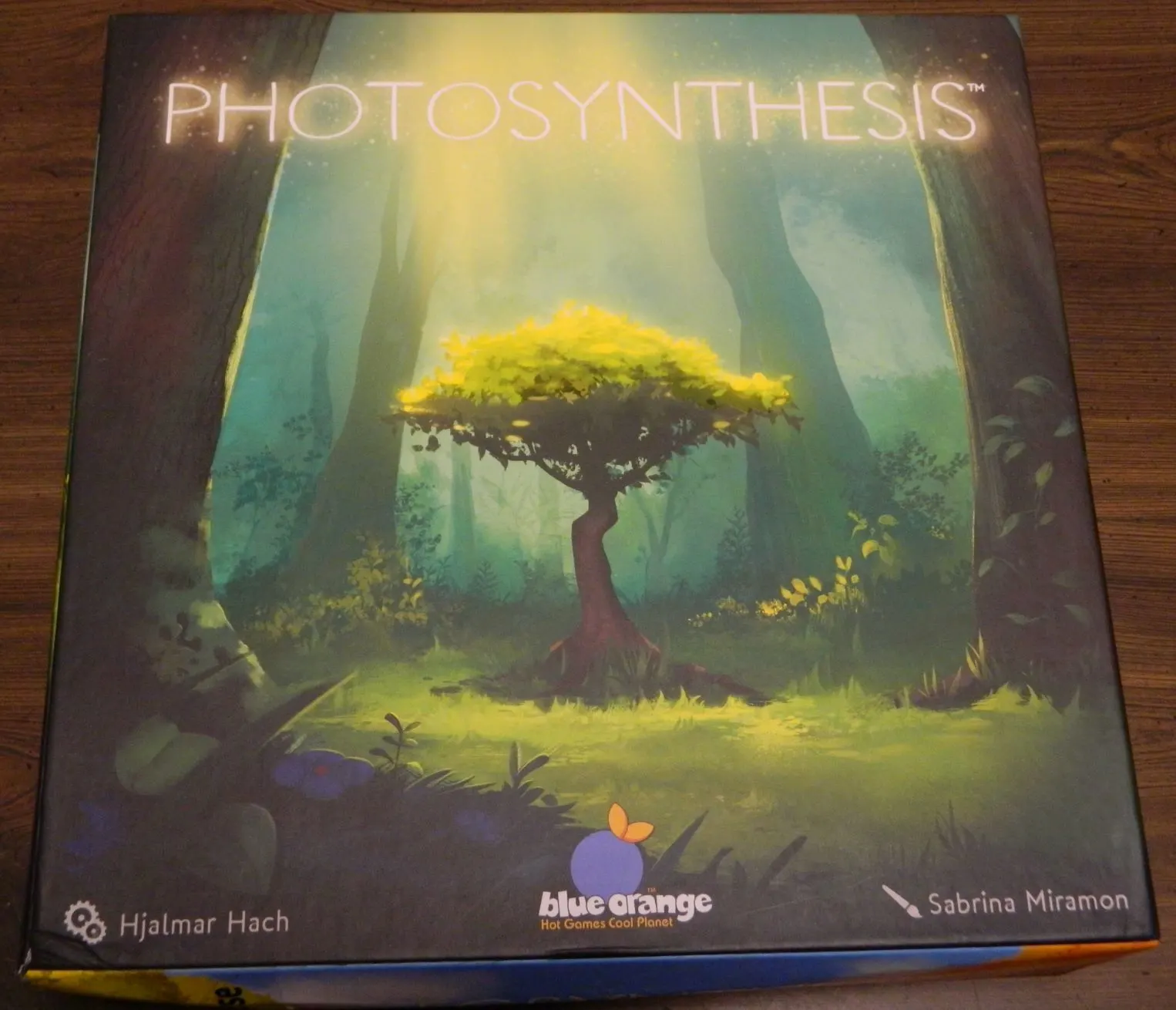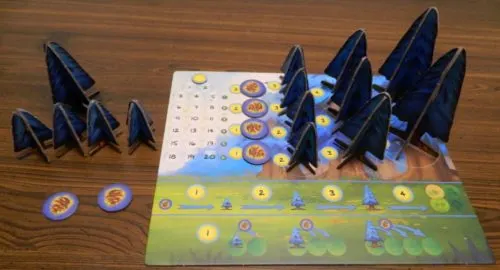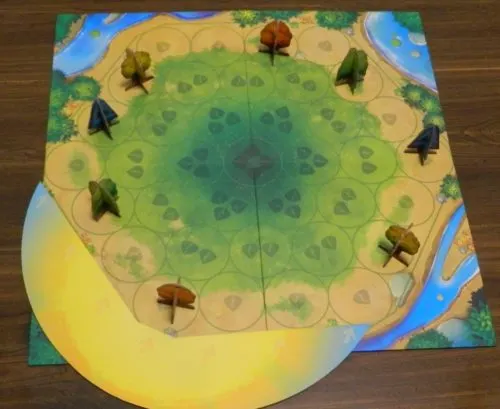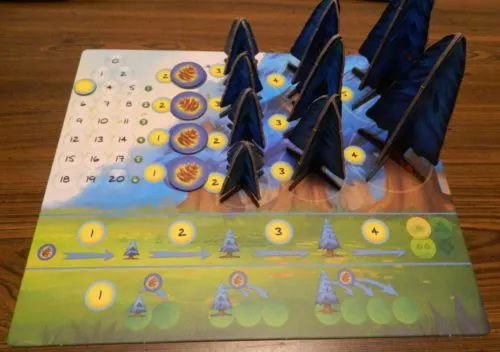Released back in 2017, Photosynthesis is a game that quickly became a hit. Just as the title aptly points out the game is about using the sun to grow plants (trees in this case). While I am no botanist or gardener, I thought this premise sounded interesting. There have been a lot of different board game themes used over the years and yet I haven’t seen a lot use this type of theme before. Photosynthesis is a game that I have been looking forward to trying out for quite some time and yet I never got around to playing it. Well that changed when Blue Orange Games sent us the game’s first expansion (the review of the expansion will be coming next week) which gave me the perfect opportunity to check out the base game. Photosynthesis is arguably the best blend between a theme and gameplay that I have ever seen which leads to an original and really fun experience that is a delight to play.
How to Play Photosynthesis
Setup
- Place the Main Board in the middle of the table.
- Each player chooses a color. They will take the Player Board, Seeds, and Trees of their chosen color. They will also take a Light Point Tracker.
- Each player will place 4 Seeds, 4 Small Trees, 3 Medium Trees, and 2 Large Trees on their Player board in the corresponding sections. The Light Point Tracker will be placed on the “0” space of the track in the top left corner.
- The remaining 2 Seeds, 4 Small Trees, and 1 Medium Tree are set next to the Player’s Board. These items will constitute the “Available Area”.
- The Scoring Tokens are sorted by the number of leaves on the back. Each set of tokens are then placed into a stack with the most valuable token on the top. If you are playing a two player game leave the four leaves tokens in the box as they won’t be used.
- The youngest player will start the game. They will be given the First Player Token to indicate that they are the first player.
- Each player will take turns placing one of their Small Trees on the main board. Players can only place their tree on one of the outside spaces (1 leaf zone). This will continue until all of the players have placed two trees.
- The Sun Segment is placed on the board in the position that shows the sun symbol. Place the 1st, 2nd, and 3rd Revolution Counters on the edge of the board with the 1st Revolution Counter on top. Leave the 4th Revolution Counter in the box unless you are playing the advanced version of the game.
Playing the Game
Photosynthesis is a game that is played over three revolutions. Each revolution consists of six different rounds. Each round consists of two phases:
- Photosynthesis Phase
- Life Cycle Phase
Photosynthesis Phase
The Photosynthesis Phase begins with the player with the First Player Token. They will move the Sun Segment clockwise one position on the board so it lines up with the next angle on the board. This is not done in the first round of a game.
Players will then score points based on the position of the sun and their Trees. Players will score light points for each of their Trees which aren’t in the shadow of another Tree. Trees that are taller than the Trees in front of them will not be affected by their shadows. The height of a Tree will determine how large of a shadow that it will cast on other Trees.
- Small Trees: 1 space shadow
- Medium Trees: 2 space shadow
- Large Trees: 3 space shadow
The height of Trees also determine how many Light Points that the Tree will acquire:
- Small Trees: 1 point
- Medium Trees: 2 points
- Large Trees: 3 points
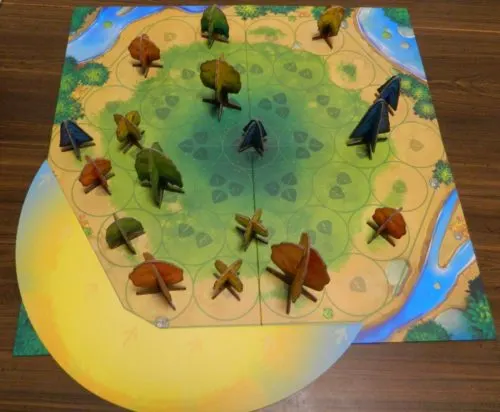
In this Photosynthesis phase players will earn Light Points as follows.
In the far left line the blue and orange Small Trees will both receive one Light Point.
In the second line the orange and green Small Trees will receive one Light Point. The yellow Small Tree won’t receive Light Points as it is in the shade of the orange Tree.
In the third line the small green Tree would receive one Light Point and the medium green Tree would receive two Light Points. The medium yellow tree would not receive Light Points as it is in the shadow of the medium green Tree.
In the fourth line the medium orange Tree will receive two Light Points and the blue and yellow Small Trees will receive one Light Point.
In the fifth line only the front yellow Small Tree will receive a Light Point as its shadow will impact the other yellow Tree.
In the sixth line the large orange Tree will receive Light Points. The other Trees won’t receive Light Points as they are in the shadows.
Finally in the seventh line the orange Tree will receive one Light Point.
Players will move their Light Point Tracker a number of spaces on their Player Board based on how many points they received.
Life Cycle Phase
During this phase the players will take turns starting with the player with the First Player Token. Players can take a number of different actions spending the Light Points they received in the Photosynthesis Phase. Players can take as many actions as they want, and can even take the same action multiple times. The only rule is that you cannot take more than one action that impacts the same space on the Main Board. Each player will take as many actions as they want. The next player clockwise will then take their actions.
Buying
The first action that a player can take on their turn is buying Seeds or Trees from their Player Board. On the right side of each Player Board is a market of Seeds and Trees of the player’s color. The number next to each space is the cost to purchase that Seed or Tree. Players can purchase any Seed or Tree size. They must buy the Seed or Tree that is in the lowest position in the market of their chosen type.
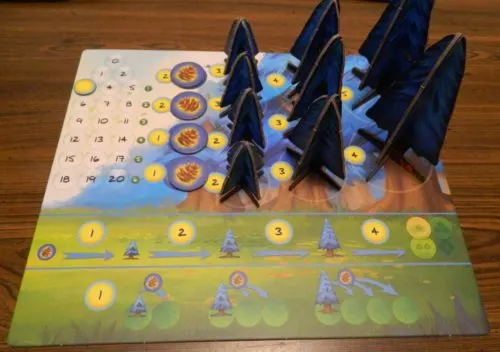
This player has three Light Points to spend. They can buy a Seed and/or a Small Tree. They could otherwise purchase a Medium Tree.
When a player purchases a Seed or Tree they will deduct the corresponding points from their Light Points track. The Seed or Tree they bought will then be moved to the player’s Available Area.
Planting A Seed
The second action that a player can take is to plant Seeds. In order to plant a Seed you need to spend one Light Point. You will then take one of the Seeds from your Available Area. The Seed can be placed on the Main Board based on one of the player’s Trees already placed on the Main Board. The number of spaces away from the Tree that a Seed can be placed depends on the height of the Tree:
- Small Tree: 1 space
- Medium Tree: 2 spaces
- Large Tree: 3 spaces.
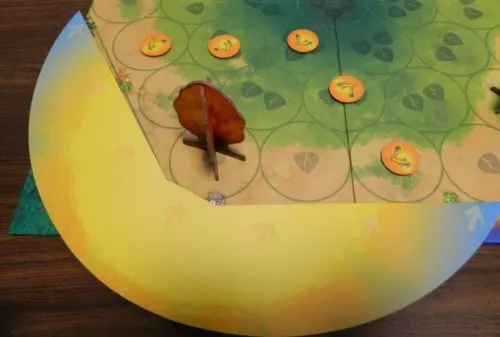
The orange player wants to plant a Seed from this medium sized Tree. They can place a Seed on one of the spaces indicated above.
During a turn a player can only use a Tree as a starting point for one Seed. A player can also not upgrade the height of a Tree and then plant a seed using that Tree on the same turn.
Growing A Tree
The third action that a player can take is to upgrade the size of one of their Trees. The cost to upgrade the size of a Tree depends on its current height.
- Seed – Small Tree: 1 point
- Small Tree – Medium Tree: 2 points
- Medium Tree – Large Tree: 3 points
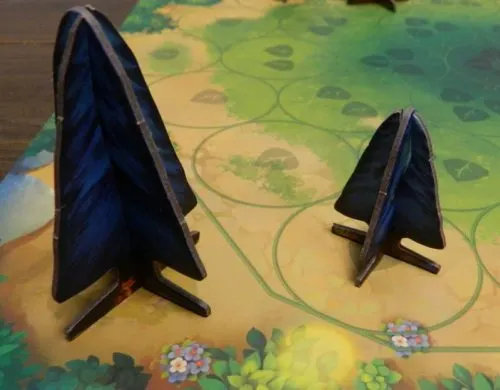
The blue player has decided to upgrade their small tree to a medium tree. This will cost two light points.
To grow a Tree you must have the next size Tree in your Available Area. When you upgrade the Tree you will replace the current Tree with the larger sized Tree. The previous Tree/Seed will then be returned to the Player’s Board to the corresponding column. The Seed/Tree will be placed on the highest available spot. If there are no spaces available in the column the Seed/Tree is returned to the box for the rest of the game.
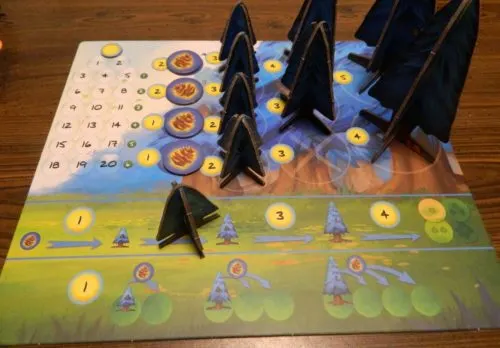
This player grew their Small Tree to a medium sized Tree. As there is no room left on their Player Board for the Small Tree they will return it to the box.
Collecting
The final action that a player can take is collecting Scoring Tokens from one of their Large Trees. This action will take four Light Points. The player will choose one of their Large Trees (on the Main Board) to use the action on. The chosen Large Tree is removed from the board and returned to the topmost spot available on the corresponding column of the player’s Player Board.
The player will then look at the space that the Tree was one. Each space features a number of leaves. The player will take the top Scoring Token from the stack that features the same number of leaves. If there are no tokens left in that stack the player will take the top token from the next pile that features one less leaf.
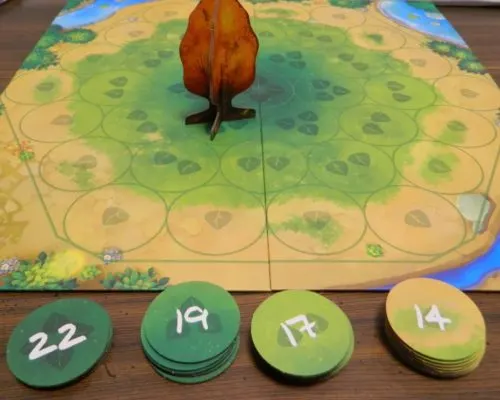
The orange player has decided to collect their Large Tree. As the Tree is on a three leaves space they will take the top Scoring Token from the three leaves pile.
End of Round
Once all of the player’s have taken their actions in the Life Cycle Phase the round will end. The First Player Token moves to the next player clockwise. The next round will then start with the Photosynthesis Phase.
After the sun has made a full rotation around the board (it has been in all six positions) the current revolution has ended. Take the top Sun Revolution Counter and return it to the box.
End of Game
The game ends after the third revolution has been completed.
Each player will then count up the points that they scored from their Scoring Tokens. They will also score one point for each three unused Light Points. Any extra Light Points are worth no points. The player with the most total points wins the game. If there is a tie the tied player with the most Seeds and Trees on the main board will win. If there is still a tie the tied players will share the victory.
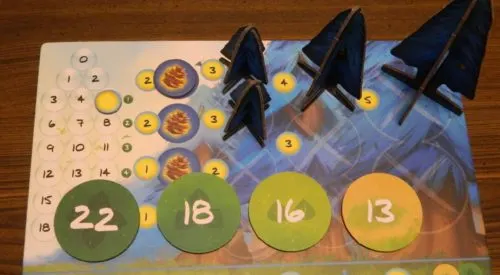
This player collected four Scoring Tokens in the game worth 69 points (22 + 18 + 16 + 13). They will also score one point for their remaining Light Points for a total of 70 points.
Advanced Game
If players want a more challenging game they can implement one or both of the following rules.
First the players can choose to also use the 4th Sun Revolution Counter which will add another revolution to the game.
Players cannot plant a Seed or grow a Tree if it is currently in the shadow of another Tree.
My Thoughts on Photosynthesis
At this point I have played around 900 different board games and I have to say that I don’t know if I have ever played one quite like Photosynthesis before. As a matter of fact I am not quite sure what I would even classify the game as. Probably the most fitting genre is an abstract strategy game, but that doesn’t quite feel right either. I think the reason that it is hard to classify the game is the fact that it really is its own unique game.
What really drives the unique gameplay of Photosynthesis is the sun mechanic. I was genuinely surprised by this mechanic as it is unlike anything that I have ever seen before in a board game. Basically the sun rotates around the board. As the game is about planting and growing trees sunlight is key in order to take actions in the game. The more sunlight you are able to collect the more actions that you can take on a given turn. Because of this a key element of the game is to track the sun and follow it. The sun will eventually shine along each side of the board, but if you can time your actions to how the sun is turning you can really maximize the amount of light points you receive.
A key element to this is the fact that the trees will cast shadows. Only part of the forest will receive sunlight each turn. If you have a tree planted in the front row that is directly in the sunlight it is guaranteed to receive sunlight. As these spaces will score you less points though they are not always the most beneficial. Thus you will be tempted by the spaces closer to the center of the board. This is where shadows become quite a bit more important. Basically you want to create some distance from the other player’s trees and you want to use height to your advantage. How you place your trees on the board in relationship to the sun and the other players’ trees will play a big role in how well you will do. Unless you do a really good job spacing out your trees you are unlikely to get a lot of sunlight every turn. Instead you are much more likely to have some rounds where you receive a lot of light points and others where you will receive few points.
To succeed in Photosynthesis you really need to do a good job thinking several turns in advance. Part of this is because you want to prepare for where the sun will be on future turns. You are much better off investing in trees that will receive sunlight in upcoming turns rather than areas where the sun just passed. The other reason why planning ahead is important is because of the rule that you can only take one action with each space each turn. For example to be able to collect from a tree you will have to plan out the process at least four rounds in advance as you have to grow a seed to a small, medium and then large tree and then use the collect action. You could maybe luck into winning without planning ahead but I wouldn’t put much chance on it. The game has a quite a few mechanics that are interconnected. The players that do the best job using these mechanics are going to have a good chance of winning the game.
Other then the unique sun mechanic I think the game deserves credit for giving players a lot of different options which adds quite a bit of strategy to the game. I genuinely enjoy games that give players a lot of options as players then feel like they are having a real impact on the game. On your turn you have four different actions that you can choose from. You can take all or some of the actions and can even take the same action multiple times. The only restriction is how many light points you have and that you can’t take two actions on the same main gameboard space. The actions are somewhat intertwined where you have to perform them in a certain order. Between the number of different actions and the number of spaces that you could perform them on, you have a lot of impact on how well you will do in the game. This leads to a really satisfying game that anyone with any interest in the game’s premise should really enjoy playing.
Between Photosynthesis’ unique mechanics and the fact that the game has a number of different actions to choose from, I was a little curious about how difficult the game would be to play. Photosynthesis is probably more difficult than most mainstream and family games and yet it is still pretty easy to play. I would guess that the game could be taught within 10-15 minutes to most players. The game has a number of different mechanics to learn. Most of them are pretty straightforward though. The game has a recommended age of 8+, but I would say 10+ is more appropriate. The game is not particularly difficult to play, but it is the type where it will take quite a bit into your first game for players to really start understanding the game’s strategy as they learn from mistakes they made earlier in the game. After a game or two though I don’t see any players having problems with the game.
The scoring structure in Photosynthesis is not exactly what you would typically expect. In most board games you usually steadily score points throughout the game with some bonus points thrown in at the end. Photosynthesis is quite a bit different. While you can choose to score points early in the game, you are usually better off waiting until the end of the second revolution or even the third revolution. When you choose to collect your trees is a really important decision in the game as it could make the difference between winning and losing. Collecting a tree earlier lets you take a higher valued scoring tokens. The problem is that by getting rid of trees too early you reduce the light points that you will receive on future turns which ultimately reduces what you can do. Because of this instead of scoring points throughout the game, at the end of the game there is a race to collect your large trees in order to score points.
Themes and board games are something that can be kind of contentious for a lot of people. Some people refuse to play a game if the theme is not good while others could care less as they are only interested in the actual gameplay. I would personally consider myself to be somewhere in the middle even though I would lean more towards gameplay over theme. For this reason theme has never been a big deal for me. A good theme is always beneficial, but it is not going to make or break a game for me. I bring this up as I have played 900 different board games and yet I don’t think I have ever played one that is as seamless as Photosynthesis.
While playing Photosynthesis it was obvious that the developer really tried to merge the theme and gameplay. I don’t know if the theme or gameplay was designed first, but I think it would have been hard to find a better combination. The collecting mechanic doesn’t make a lot of sense with the theme, but all of the other gameplay mechanics feel like they were genuinely crafted with the theme in mind. I am genuinely not a big fan of themes in board games as it mostly just feels like window dressing. In Photosynthesis the theme and gameplay feel as if the game wouldn’t be the same if you took one of them away.
Supporting the theme is the fact that the game’s components are quite good. The mini trees are obviously the standout. The trees consist of two cardboard pieces that are slid together to form a three dimensional tree. The trees show quite a bit of detail including each color being a different type of tree. When players start to build out the forest it really starts to look like one. The only problem with the trees is that it can sometimes be a little hard to tell a medium tree from a large tree. Other than the trees the rest of the components are cardboard. The cardboard pieces are thick where they should last. What brings all of the components together are the game’s great art style that works really well for the game. I honestly thought the components were really good.
So I have spent most of this review talking about what I liked about Photosynthesis. The game is really good, but it is not perfect. I just felt there were a couple issues that prevented it from being quite as good as it could have been.
The first issue that I had with the game is that it can feel a little long at times. There are a couple of factors that play a role in this. In particular your first game is going to take some time. I attribute this to the fact that Photosynthesis features quite a few mechanics that you don’t really see in other games. This means that your first game will take more time as players adjust to these mechanics. Future games will take less time as you get used to the mechanics. The bigger problem is the fact that there is the potential for analysis paralysis. The decisions in the game are pretty simple, but the game gives you a lot of flexibility in what you choose to do. In some rounds you won’t have many light points which will limit what you can do. In other rounds you have a ton which opens up a lot of possibilities. For players that want to maximize their score there are a ton of different options to consider. If you want to analyze all of the different options it will take a long time to consider them. To make sure the game doesn’t drag on for too long though players should agree to a time limit for each turn. This will speed up the game and prevent players from having to sit around waiting for one of the players to make a decision.
The other issue with the game is the fact that despite the theme the game can actually be quite mean. Players don’t have a lot of direct control over the other players, but they can have a lot of indirect control. For most of the game players are doing their own things as how they spend their light points don’t impact the other players. Where a player can really impact another player though is through the trees they place on the main board and which they decide to grow. How a player places their seeds and how they grow their trees can have a big impact on the other players. This is due to the ability to place a tree that blocks another player’s tree(s) from receiving light points. Usually you can only impact a player for one or two of the phases of the sun, but with a concerted effort you could really mess with the amount of light points that another player receives. This will significantly impact what the other player is able to do. For this reason a player can fall behind early and never be able to catch up as they will always be behind.
Should You Buy Photosynthesis?
I have played a lot of different board games and I don’t know if I have ever played one quite like Photosynthesis. This starts with the fact that I don’t think I have ever played a game that has so seamlessly matched the theme with the gameplay. This is supported even further by the components which are excellent. The real standout of the game though is the sunlight mechanic. I don’t know if I have ever seen a similar mechanic in a board game before. This mechanic drives the entire game as almost all of your decisions in the game are based around trying to capture the most sunlight. This leads to some cutthroat moments where players can really mess with one another, but you need to work around the shadows. To do well in the game you need to think several turns in advance as many of the mechanics are intertwined. The game has quite a bit of strategy between the different options you have to choose from, and yet the game is still not that hard to play. The game is susceptible to analysis paralysis though as games sometimes take longer than they should.
My recommendation for Photosynthesis is pretty simple. If the game’s premise or theme intrigues you at all I would highly recommend checking out Photosynthesis as it is a great game that you will likely really enjoy.
Buy Photosynthesis online: Amazon, eBay
Be sure to check back next week for the review of Photosynthesis’ first expansion Photosynthesis Under the Moonlight.

